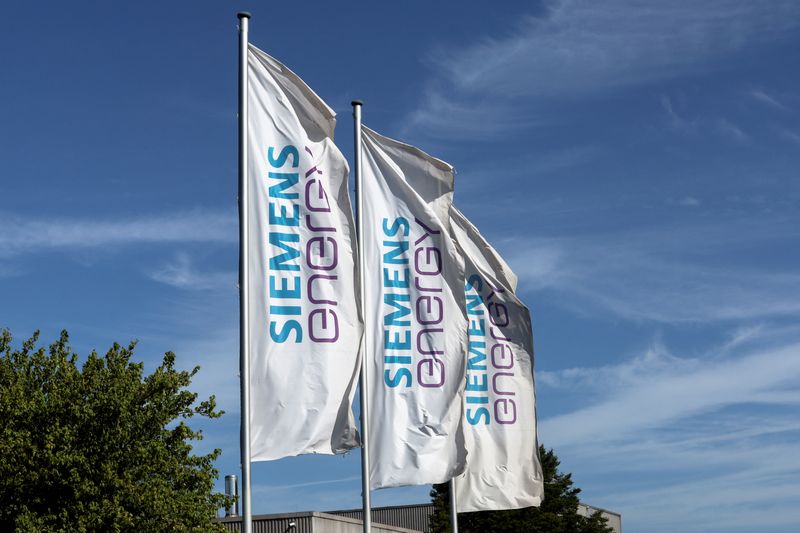By Christoph Steitz and Nina Chestney
FRANKFURT/LONDON (Reuters) - Siemens Energy's disclosure of quality issues in its newer wind turbine models has exposed broader challenges in a sector suffering from rushed development, soaring materials costs and a flawed market design.
Siemens Energy shocked the wind sector in late June when it warned of faulty components and possible design faults in its onshore wind turbines.
It said it could not yet quantify the cost, but anticipated the issues would take at least 1 billion euros ($1.1 billion) to fix. Company sources, speaking on condition of anonymity, have said the final bill could be even higher.
The losses also highlight structural issues in a sector that has been in need of reform for years, according to sector advisers, industry executives and analysts.
Last year, the four biggest Western wind turbine makers - Vestas, GE, Siemens Energy's Siemens Gamesa and Nordex made combined sales of more than 41 billion euros. Combined losses exceeded 5 billion euros.
Wind farm owners at the same time earned a 15% operating margin, data from consultancy Wood Mackenzie showed, evidence of an uneven profit distribution in the sector.
Given the nature of contracts agreed before the recent inflation surge, the sector has struggled to pass on the increased cost of materials.
Energy majors that had been moving into renewable energy have to an extent retreated, under pressure from shareholders focused on the more reliable profits generated by oil and gas.
In the wind sector, Siemens Energy stands out because its turbine division resulted from a botched merger of two original equipment manufacturers (OEM) that gave rise to a culture of cutting corners and insufficient quality checks, people familiar with matter said.
Even so, "everybody was surprised by the magnitude," one of them said of the June disclosures, adding that Siemens Gamesa had been involved in too many parts of the value chain and that more needed to be outsourced to save costs and raise quality.
Analysts at brokerage Bernstein, outlining their bear case scenario for the problems at Siemens Energy, said the company's difficulties could be seen as "teething problems of an arms-race to expand blade diameter", dubbing the issue a potential "turbinegeddon" for the sector.
Some of the pressure for speed has come from European Union goals to increase renewable energy output to tackle climate change and, since Russia's invasion of Ukraine, to reduce reliance on imported Russian gas.
The EU wants wind energy to make up 43% of Europe's electricity consumption by 2030, up from 17% now.
At the same time, supply chain disruption linked to the COVID-19 pandemic has added to the difficulty of producing enough turbines.
Equipment-makers have raced to build bigger and more efficient turbines to keep up with rivals, without necessarily allowing time for quality checks.
"The strong competitive pressure along with the race for 'the latest and greatest' has forced manufacturers to shorten development cycles - and to offer prototypes," said Udo Schneider of Green Giraffe, which advises clients on large energy transition projects.
Siemens Gamesa's 4.X and 5.X turbines, the two onshore platforms at the centre of the company's problems, were introduced to the market within two years, a cycle industry experts say is too short.
ECONOMIES OF SCALE ELUSIVE
Even as demand has increased, the need to customise turbines to cater for individual markets and different wind speeds has prevented the sector from launching profitable mass production, industry advisers say.
Siemens Energy's rival General Electric (NYSE:GE), for example, posted a $2.24 billion loss at its renewable energy division in 2022, partly blaming "corrective measures and repair campaigns" in its turbine fleet.
To try to standardise production, raise quality and cut costs, GE has said it will reduce the number of rotor models it makes to four from 15, turbine covers to four from nine, and tower models to nine from 40.
Denmark's Vestas, too, has been making quarterly warranty provisions to cover increased turbine repairs and upgrades.
China, the world's largest renewables market is effectively closed to Western players, but industry sources say it is also affected by the issues of the wider sector.
"Industry wide, there's a problem of product testing and validation not being sufficient," said a source at one of China's largest wind turbine makers, who declined to be named.

"Before type testing is performed and validated, the order is already signed."
($1 = 0.9167 euros)